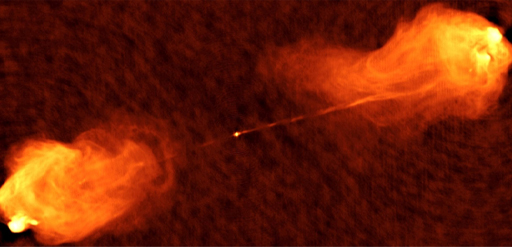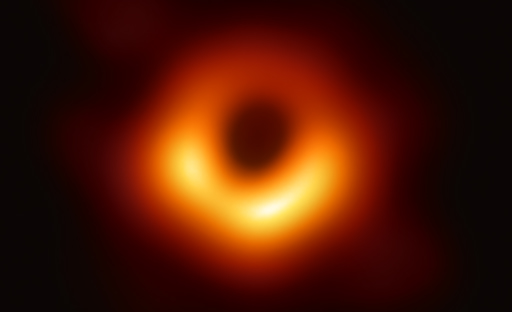7.1 A picture of a black hole
You might think that a black hole, being black and absorbing all the light that falls on it, would be invisible. In a sense that’s true. But there are ways to ‘see’ a black hole.
Since the 1950s, astronomers have been intrigued by distant, powerful sources of radio waves known as radio galaxies. It’s now known that these are otherwise normal galaxies with a supermassive black hole – billions of times heavier than the Sun – in the centre. Material from the galaxy is accelerated to high speed by the intense gravity and heated as it swirls around the black hole, before ultimately disappearing through the event horizon. Vast amounts of energy are released in the process (in the form of x-rays and radio waves), and jets of material are often thrown out in opposite directions. So, although the black hole itself is not visible, the violent activity in its surroundings gives away its location. Figure 7 shows an example of this – the radio galaxy Cygnus A lies at the centre of this image showing radio emission. Two high-energy jets are ejecting plumes of material from a black hole at its centre.
It’s now thought that most, if not all galaxies – including our own Milky Way – have a massive black hole at the core. Fortunately for us, the Milky Way black hole, with a mass about 4.5 million times that of the Sun, appears to be sitting quietly without any sign of such violent outbursts.
In 2019, astronomers published the first picture that revealed the event horizon of a black hole (Figure 8). It was made by eight radio telescopes around the world working together to form the Event Horizon Telescope.
This black hole, in the centre of an active galaxy called M87, has a mass about 6.5 billion times that of the Sun, and the event horizon is 40 billion kilometres in diameter. The central dark area in the picture is the shadow of the black hole itself, extending to about three times the radius of the event horizon. Radiation from the extremely hot gas swirling around the hole is distorted into a ring shape by the strong curvature of space in the vicinity.
Before this image, astronomers were reasonably confident that the black hole theory of active galaxies was correct. The image confirmed it, along with the predictions of general relativity.
None of this makes the idea of entering a black hole sound particularly appealing. But what would actually happen if you did?


